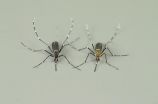(Press-News.org) Nearly a quarter of all patients who underwent initial breast conservation surgery (BCS) for breast cancer had a subsequent surgical intervention, according to a report published online by JAMA Surgery.
Completely removing breast cancer is seen as the best way to reduce recurrence and improve survival. A lack of consensus on an adequate margin width has led to variable rates of reexcision and, as a result, patients undergo repeat or additional surgeries, according to background information provided in the study.
Lee G. Wilke, M.D., of the University of Wisconsin School of Medicine and Public Health, Madison, and fellow co-authors looked at patient, tumor and facility factors that influenced repeat surgery rates in U.S. patients undergoing BCS from 2004 through 2010. The authors' study included 316,114 patients with diagnosed breast cancer (stage 0 to II) who had initial BCS. Patients initially treated with chemotherapy to shrink their tumors (neoadjuvantly treated) or those who were diagnosed by excisional biopsy were excluded.
The study found 241,597 patients (76.4 percent) underwent a single lumpectomy and 74,517 patients (23.6 percent) had at least one additional operation. Of the patients who had an additional operation, 46,250 (62.1 percent) had a completion lumpectomy and 28,267 (37.9 percent) underwent mastectomy. The proportion of patients undergoing repeat surgery decreased during the study period from 25.4 percent to 22.7 percent. Tumor size and histologic subtype were the two most notable patient factors associated with repeat surgeries. Academic research facilities had a 26 percent repeat surgery rate compared with a 22.4 percent rate at community facilities. Facilities in the Mountain region of the U.S. were less likely to perform repeat surgery compared with facilities in the Northeast (18.4% and 26.5% respectively).
"These findings can be used by surgeons to better inform patients regarding repeat surgery rates and how patient or tumor characteristics influence these rates. More important, these data can be used to further support the vitally important adoption of guidelines regarding reexcision after initial BCS. Standard definitions of adequate margins as set forth in the consensus guidelines by the Society of Surgical Oncology and the American Society for Radiation Oncology and the indications for reexcision will decrease the wide variation in repeat surgery rates and decrease costs and patient anxiety surrounding tumor-positive margins," the authors conclude.
(JAMA Surgery. Published online November 12, 2014. doi:10.1001/jamasurg.2014.926. Available pre-embargo to the media at http://media.jamanetwork.com.)
Editor's Note: Please see the article for additional information, including other authors, author contributions and affiliations, financial disclosures, funding and support, etc.
Commentary: Breast Conservation Surgery, Definition of Adequate Margins
In a related commentary, Julie A. Margenthaler, M.D., Washington University School of Medicine, St. Louis, and Aislinn Vaughan, M.D., of the Sisters of St. Mary's Breast Care, St. Charles, Mo., write: "The Society of Surgical Oncology and the American Society for Radiation Oncology developed a consensus statement, supported by systematic review data, encouraging adoption of 'no tumor on ink' as the standard definition of a negative margin for invasive stage I and II breast cancer. It is time to put our biases aside. We have robust evidence that additional operations for close, but negative, margins do not result in better outcomes."
"However, additional operations increase health care costs, misuse of resources, patient anxiety and delay in adjuvant therapy. With more than 200,000 new invasive breast cancers diagnosed each year, a staggering number of women are undergoing procedures that are unnecessary and simply wasteful. Our hope is that the Society of Surgical Oncology and the American Society for Radiation Oncology guidelines will be rapidly adopted by surgeons. Data from the study by Wilke et al will provide an excellent historical reference for future investigation of the success of this paradigm shift," the authors conclude.
(JAMA Surgery. Published online November 12, 2014. doi:10.1001/jamasurg.2014.950. Available pre-embargo to the media at http://media.jamanetwork.com.)
Editor's Note: Please see the article for additional information, including other authors, author contributions and affiliations, financial disclosures, funding and support, etc.
INFORMATION:
Media Advisory: To contact author Lee G. Wilke, M.D., call Susan L. Smith at 608-890-5643 or email SSmith5@uwhealth.org. To contact corresponding commentary author Julie A. Margenthaler, M.D., call Jim Goodwin at 314-286-0166 or email Jgoodwin@wustl.edu.
A study that looked at predicting suicides in U.S. Army soldiers after they are hospitalized for a psychiatric disorder suggests that nearly 53 percent of posthospitalization suicides occurred following the 5 percent of hospitalizations with the highest predicted suicide risk, according to a report in JAMA Psychiatry.
The suicide rate in the U.S. Army has increased since 2004 and now exceeds the rate among civilians. Still, suicide is a rare outcome even among recently discharged psychiatric patients. A potentially promising approach to assess posthospitalization suicide ...
SEATTLE - Preterm birth is now the leading cause of death for children under 5 worldwide, and a new scientific paper reveals a startling lack of knowledge about what causes it and how to prevent it.
Published in the November issue of Science Translational Medicine, "Prevention of Preterm Birth: Harnessing Science to Address the Global Epidemic" shines a light on the urgent need for a larger, coordinated research effort to discover how to identify women at risk of preterm birth and develop prevention interventions.
"There are not enough resources dedicated to researching ...
Older women with disordered breathing during sleep were found to be at greater risk of decline in the ability to perform daily activities, such as grocery shopping and meal preparation, according to a new study led by researchers at the Johns Hopkins Bloomberg School of Public Health and the University of California, San Francisco.
The study was published Nov. 6 in the online edition of the Journal of the American Geriatrics Society.
The findings are notable given the aging of the population - an estimated 3.7 million Americans will turn 65 in 2015, and by 2030, 19 ...
In school-age children previously diagnosed with depression as preschoolers, a key brain region involved in emotion is smaller than in their peers who were not depressed, scientists have shown.
The research, by a team at Washington University School of Medicine in St. Louis, also suggests that the size of the brain's right anterior insula may predict the risk of future bouts of depression, potentially giving researchers an anatomical marker to identify those at high risk for recurrence.
The study is published online Nov. 12 in the journal JAMA Psychiatry.
There is ...
One of the world's deadliest mosquitoes sustains its taste for human blood thanks in part to a genetic tweak that makes it more sensitive to human odor, according to new research.
Researchers report in the journal Nature that the yellow fever mosquito contains a version of an odor-detecting gene in its antennae that is highly attuned to sulcatone, a compound prevalent in human odor. The researchers found that the gene, AaegOr4, is more abundant and more sensitive in the human-preferring "domestic" form of the yellow fever mosquito than in its ancestral "forest" form that ...
Adding tiny amounts of vegetable puree to milk and then rice at the time of weaning makes children more likely to eat vegetables, new University of Leeds research shows.
Infants who consumed either milk (breast milk or formula) followed by rice mixed with vegetable puree ate nearly half as many vegetables again as infants who ate just milk followed by baby rice.
Professor Marion Hetherington, of the School of Psychology at the University of Leeds, led the study. She said: "We took inspiration from French mothers, as previous studies in this area have shown that they ...
(SACRAMENTO, Calif.) -- In its first clinical application in pediatric patients, an investigational medication developed and manufactured at UC Davis has been found to effectively treat children with life-threatening and difficult-to-control epileptic seizures without side effects, according to a research report by scientists at UC Davis and Northwestern University.
The investigational formulation of allopregnanolone was manufactured by UC Davis Health System's Good Manufacturing Practice Laboratory. Two children were treated with the allopregnanolone formulation, one ...
LA JOLLA, CA - November 12, 2014 - Driving to work becomes routine--but could you drive the entire way in reverse gear? Humans, like many animals, are accustomed to seeing objects pass behind us as we go forward. Moving backwards feels unnatural.
In a new study, scientists from The Scripps Research Institute (TSRI) reveal that moving forward actually trains the brain to perceive the world normally. The findings also show that the relationship between neurons in the eye and the brain is more complicated than previously thought--in fact, the order in which we see things ...
(MEMPHIS, Tenn. - November 12, 2014) An international collaboration has identified frequent mutations in two genes that often occur together in Ewing sarcoma (EWS) and that define a subtype of the cancer associated with reduced survival. The research, conducted by the St. Jude Children's Research Hospital-Washington University Pediatric Cancer Genome Project and the Institut Curie-Inserm through the International Cancer Genome Consortium, appears in the current issue of the scientific journal Cancer Discovery.
Mutations in the genes STAG2 and TP53 have previously been ...
Giant otters may have a vocal repertoire with 22 distinct vocalization types produced by adults and 11 neonate vocalization types, according to a study published November 12, 2014 in the open-access journal PLOS ONE by Christina Mumm and Mirjam Knörnschild from University of Ulm, Germany.
Giant otters, found in South America, are very social and frequently vocalizing animals. They live in groups that may vary, but generally include a reproductive pair and their offspring, born in different years. Individuals engage in shared group activities and hold different social ...


